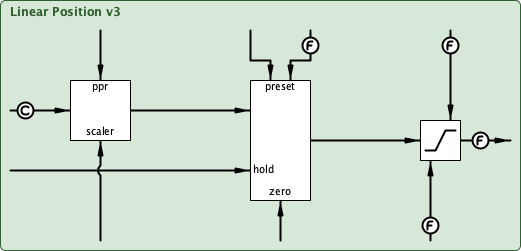Provides the actual, current position with floating point accuracy and flexibility. A preset facility and clamps are provided. Counts that cause the position to exceed the clamps are discarded. Counts in the opposite direction are counted. The clamps are designed to support special applications;
- Hard-stop, break-away clutch motors. Counts past the stop position are ignored. Any count in the opposite direction is assumed to be movement off the stop.
Rotary operator setpoint dial with no stops. Turning the dial past the setpoint clamp has no effect. Any rotation in the opposite direction has immediate effect.
The count input is freely connectable from any single Encoder or FI function block Count output in any smarty on the local network.
With Pulses/Rev and floating-point Scaler parameters, the output can be scaled as desired, e.g. meters or millimeters.
The Set Zero input predominates over Hold and Preset. Preset predominates over Hold
The Output is zero when Set Zero is Active
Asserting the Preset Enable input causes the output to be set to the preset value.
Hold input causes the output to hold at its current value and discard any ongoing counts. The output increments from the current value when made Inactive.
Transitions of Set Zero, Preset, or Hold should not be commanded while the count is actively incrementing. Transitions that occur while the count is actively changing will be associated with an uncertainty equal to the revs per second times the timebase setpoint of the containing device.
- Example of position uncertainty from dynamic transitions -
The Linear Position function block is located in a speedy with the default timebase, 5ms.
The count is from an encoder spinning at 1800RPM.
Preset is asserted momentarily by passing a prox switch.
1800RPM / 60s x 0.005s = 0.15 rev uncertainty with transitions at full speed.
Eliminate dynamic position uncertainty with other motion control function blocks having high-speed event input capability; Registration, Event Measurer, Event Timer.
The function block Status is Fault and the function block output is zero if the count input is not updated for a period longer than approximately twenty times the timebase, i.e. 100ms, by default.
Design a complete motion control solution with three function blocks. The following pictures show examples of Linear Position v3 function block in three different systems. The first allows an index command to choose any position along evenly divided intervals. The second allows up to 100 positions to be pre-defined and selected via an index. The third system accepts explicit position commands.





